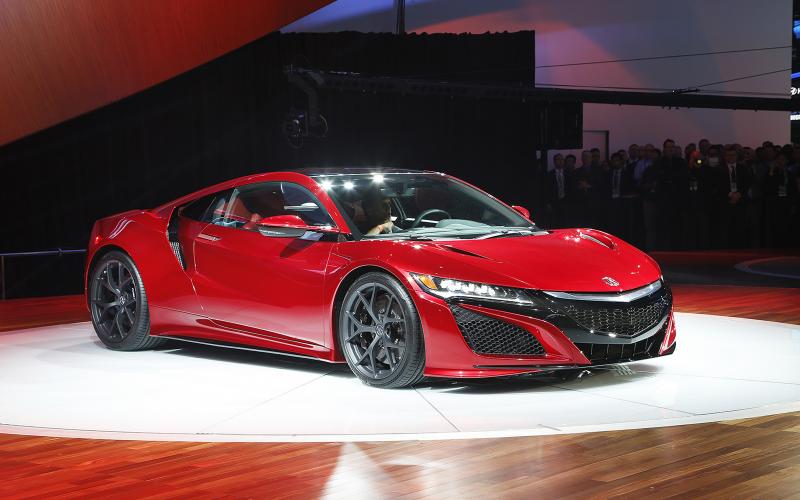Honda NSX supercar reborn as a 550bhp hybrid with a twin-turbo V6 and three electric motors; on sale in late 2015
 Two electric motors on the NSX drive the front wheels
Two electric motors on the NSX drive the front wheels
This is the all-new, second-generation Honda NSX, which was revealed at the Detroit motor show this week, some 25 years after the launch of its iconic predecessor. The new car has been developed in the US and will be produced in the new Performance Manufacturing Centre in Marysville, Ohio.
Although the new NSX is built around a lightweight structure and has a mid-mounted V6 engine, that is where the resemblance to the original, all-aluminium NSX ends. The new model has a petrol-electric hybrid powertrain driving all four wheels and a new multi-material structure with an ultra-stiff carbonfibre floor.
The heart of the NSX’s powertrain is a 75-degree, twin-turbocharged V6, which drives an all-new nine-speed dual-clutch automatic gearbox. On top of this, the NSX’s ‘sport hybrid’ system incorporates three electric motors.
Honda hasn’t officially revealed the powertrain’s power and torque outputs yet, but it is expected to produce a system total of about 550bhp.
The V6 has a dry-sump lubrication system and ‘compact’ valvetrain designed to allow the motor to be mounted as low as possible in the body, helping to lower the car’s centre of gravity. Honda says the nine-speed DCT is capable of “synapse-quick” shifts and executes rev-matching downshifts.
One of the three electric motors is housed between the engine and gearbox and is said to support “acceleration, braking and transmission shifting performance”.
The other two motors are mounted on the NSX’s front axle. Each motor drives an individual wheel, not only delivering “instantaneous torque”, according to Honda, but also providing dynamic torque vectoring.
Each motor drives a front wheel and can apply differing levels of torque, “enhancing acceleration and braking performance”. This set-up can also deliver “zero-delay launch and braking performance”, the company says. Agile Handling Assist (AHA) uses “subtle application of brake torque to further enhance response and dynamic stability”.
The NSX has four switchable chassis modes. Quiet mode allows the car to be driven on battery power only for short distances. The other modes - in an ascending order of dynamism - are Sport, Sport+ and Track. Honda claims the latter “reveals the full spectrum of the NSX’s capabilities”.
The structure of the new NSX is described as a spaceframe design that is constructed from ultra-high-strength steel and aluminium. The floor of the structure is made of carbonfibre and the cabin features “ultra-thin” A-pillars.
The NSX also features a “world-first [aluminium] casting process that combines the benefits of both cast and forged components”. The body panels are made from a combination of aluminum and sheet moulding composite.
At 4470mm long, the NSX is about 40mm longer the original, as well as 130mm wider and 45mm higher. The front track is a significant 145mm wider and the rear track 75mm wider. The car’s shape was aerodynamically refined in Honda’s Ohio wind tunnel.
Under the skin, the NSX’s T-shaped battery pack is mounted down the car’s centre tunnel and behind the seats. Suspension is by aluminium double wishbones all round and the car rolls on 8.5x19in front and 11x20in rear wheels.
The braking system features carbon-ceramic discs with six-pot calipers on the front and four-pot calipers at the rear.
The order books for the new NSX will open in the summer and the first examples should be delivered towards the end of this year. The likely price has yet to be revealed.
Officials have confirmed to Autocar that a right-hand drive version of the NSX will be made, with the aim to have that model on sale before the end of 2015. Just 1419 examples of the original NSX were sold in Europe between 1990-2007, from 18,700 sales globally.



No comments:
Post a Comment